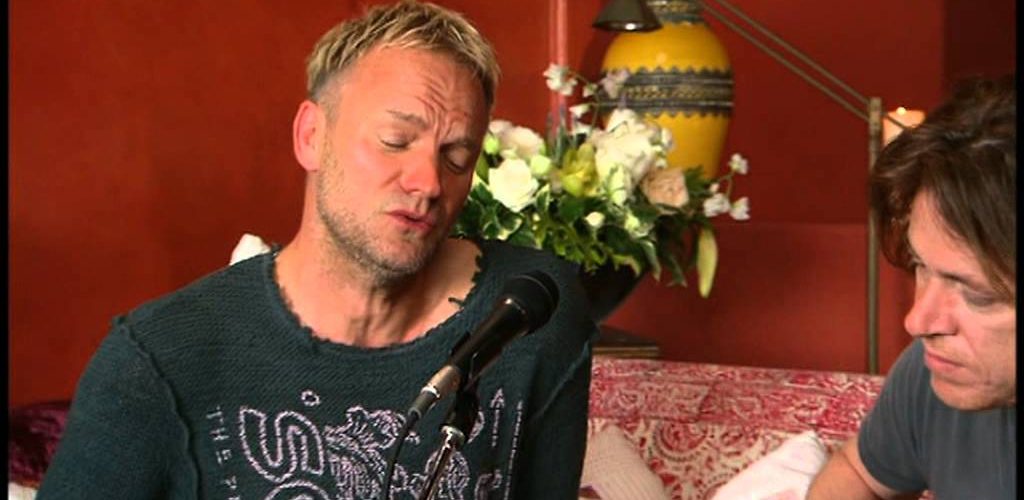Video length: 4 minutes 32 seconds
Artist website: dominicmiller.com – sting.com
Musicians
Dominic Miller – acoustic guitar
Sting – vocals
What makes this video great and what can you learn from it?
- intimate performance of an awesome Pop song
- the opportunity to clearly see what Dominic Miller is doing
- observe the interplay between Dominic and Sting
- the “less is more” philosophy in action – sparse playing can be very effective and lets the song shine
What can you learn from the article?
- the theory behind triads
- how to turn regular triads into open-voiced triads
- how to construct open-voiced triad shapes on guitar
- how to form the 10th interval as a subset/byproduct of open-voiced triads
- how a focus on voice-leading can introduce interesting chord variations
- chord embellishments via hammer-ons and pull-offs
- solve chord-grip difficulties by using an unorthodox finger-shifting technique
- how to make a difficult chord shape easier by using an open string (when possible)
- the picking pattern used for “Shape of My Heart”
- horizontal vibrato vs. vertical vibrato
Key Moments in “Shape of My Heart”
| technique/concept | video timestamp |
|---|---|
| Open-voiced triads | 0:00-0:11 (and throughout the song whenever this part is played again) |
| Chord synonyms, embellishments (hammer-on/pull-off) & suspension | 0:02-0:04 (synonyms), 0:05-0:06 (suspension), 0:14-0:15 (hammer-on/pull-off embellishment) |
| Modulation | 2:19-2:46 |
| Strumming | 2:36-2:45 |
| Horizontal vibrato | 0:02, 0:08, 0:13, 0:46, 1:36-1:38, 1:41, 2:52-2:55 |
| Added melody | 0:17-0:21 |
| Color chords for dramatic ending | 4:14-4:27 |
“Shape of My Heart” by Sting (and Dominic Miller as co-writer) is the 5th single released from the “Ten Summoner’s Tales” album and one of my all-time favourite songs. Deceptively simple with a great chord progression, a memorable melody, evocative lyrics and impeccable playing it has all the ingredients of a modern Pop-classic and masterpiece.
I know that the spades are the swords of a soldier
Chorus Lyrics – Shape of My Heart
I know that the clubs are weapons of war
I know that diamonds mean money for this art
But that’s not the shape of my heart.
Lots of people associate this haunting track with the Luc Besson movie “Leon – The Professional” where it was used during the final credits. “Leon” covers the story about the unusual relationship between the illiterate hitman Leon (played by Jean Reno) and the 12-year-old girl Mathilda (played by Natalie Portman). Mathilda’s family has been murdered by corrupt DEA agents and she wants Leon to help her take revenge.
Triad Types and Inversions
The most basic chord type (apart from the power chord) is the triad – consisting of three notes, stacked in thirds. Yes, there are other options to create harmony – quartal harmony, quintal harmony, clusters etc. But the foundation is the good ol’ tertian (based on thirds) harmony.
With two types of 3rds (major and minor) as building blocks, there are four types of three-note chords possible. Stack two major 3rds on top of each other and the result is an augmented triad – the least commonly used triad in popular music (1-3-#5). Combine a major 3rd and minor 3rd and the end result is a major triad (1-3-5). Reverse that order (the minor 3rd on the bottom and the major 3rd interval on top) and you get a minor triad (1-b3-5). Two minor 3rds on top of each other and the result is a diminished triad (1-b3-b5).
Check out the following table for a summary and an opportunity to compare the various chord types!
| Chord Type | Chord Symbol (for C root note) | Chord Formula | Stacked Interval Structure | Chord Notes (for C root note) |
|---|---|---|---|---|
| major | C | 1 – 3 – 5 | 3 + b3 | C – E – G |
| minor | Cm or Cmi | 1 – b3 – 5 | b3 + 3 | C – Eb – G |
| diminished | Cdim | 1 – b3 – b5 | b3 + b3 | C – Eb – Gb |
| augmented | Caug or C+ | 1 – 3 – #5 | 3 + 3 | C – E – G |
That’s it. All the basic tertian-based chord types. However, there are a few more options to make things interesting. For instance, when you change the order of notes you get something called an inversion.

The initial order (1-3-5) is the root position. Put the bottom (root) note up an octave so that it becomes the top note of the chord and you have a new arrangement of notes: 3-5-1.
This 1st inversion still has the same chord quality (meaning it continues to be a major, minor, diminished or augmented chord – depending on what you started with), but has a subtly different kind of sound due to the different intervals inside its internal structure. For instance, in the 1st inversion there is a perfect 4th interval between the 5th of the chord and the root note placed above it. Remember, in the root position we were only dealing with 3rds.
Change the order to 5-1-3 and you have the so-called 2nd inversion with yet another change of feel/sound.
But wait, there’s more…
Open-Voiced vs. Close-Voiced Chords
There’s yet another way to change the sound apart from the inversion choice. This other way is especially useful for us guitar players. For demonstration purposes, let’s take the basic C chord root position. You already know why it’s called root position, right? Because the root is the lowest note. When the notes are as close together as possible, we call this voicing of notes close-voiced .
The alternative is called an open-voiced triad. To build an open-voiced triad, simply take the middle note of the close-voiced triad and put it up an octave. Now the notes are spread out, farther apart and you get a more open sound.

Open-Voiced Triads on Guitar
Let’s check out a systematic approach that will help you get started on the road towards accomplishing this goal. We start on the lowest string set and look at the standard triad shapes first.
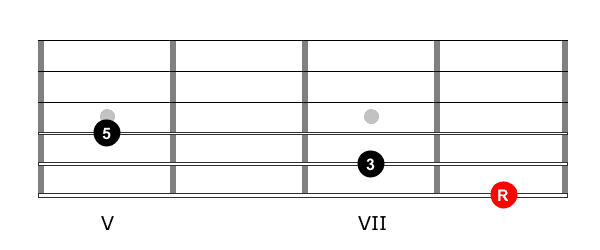
Take the middle note and put it up an octave and there you have a nice-sounding C open-voiced C triad in root position.
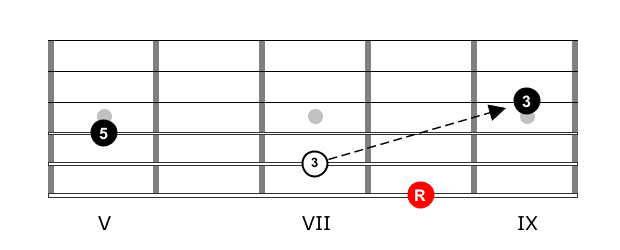
If the stretch is too large for you, look for an alternative – almost always you can find a different shape by changing the string you place a note on.

The resulting shape might be easier with the trade-off that the right hand picking constellation is different from other inversions. This creates inconsistency and can introduce timbral changes when connecting different chords in a progression. It’s no deal breaker, but something to be aware of.
The “trick” for mastering the variety of chord types and shapes is to keep the function of notes in mind. Don’t just blindly memorize a chord shape. Try to understand the formula of the chord (meaning what notes are required for the chord symbol) and where in the voicing the notes are located. Then it’s not too difficult to modify each shape to arrive at additional chord qualities. The main benefit is that you don’t have to try to remember a ton of different shapes, which gets confusing rather quickly. Instead you master a few key shapes which you then simply modify and adapt to suit the situation.
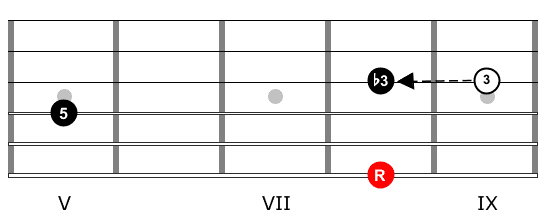
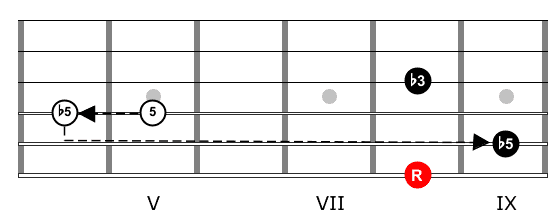
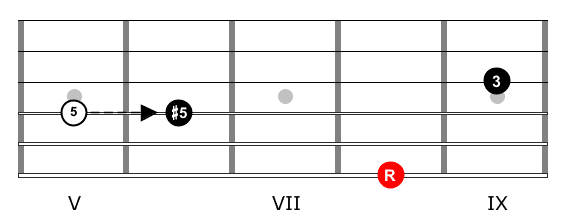
Do this kind of shape-adaptation with the inversions and before you know it, you will have integrated 12 chord shapes (4 qualities x 3 positions = 12 shapes) on that particular string set. Move to the next string set and repeat the process!
Homework assignment (sorry, as a guitar teacher I simply can’t help myself): learn all the shapes of the four basic triadic chord qualities in all inversions on all string sets! Once you have those forms under your fingers, practice them in all keys utilizing the cycle of fourths. Take your time – that’s nothing to accomplish in a quick once-off session. As always, anything worthwhile requires both time and effort. But trust me, the incredibly useful open-voiced triads are worth the effort.
Open-voiced triads: 0:00-0:11 – back to overview
The “Magical” 10th Interval
If you really struggle with the stretches and don’t like the alternative chord shapes where you change a note to a different string, focus initially on the 10th interval by ditching the 5th. This creates a separate shape that is a lot easier to play. Especially for major and minor triads, the 5th is not a defining chord tone and can be left out without losing anything harmonically. Instead of struggling and dealing with the increased potential for mistakes, you zone in on what’s essential and deliver the necessary tones defining the harmony.
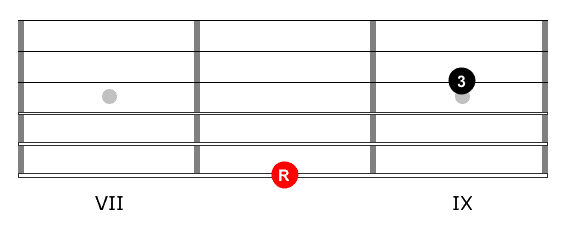

Congratulations, now you hold the key to playing large parts of Justin Bieber’s “Love Yourself”. You just have to transfer the shapes up a string-set and adjust the missing half-step on the B-string. If that doesn’t get you motivated, I don’t know what would. In the almost impossible case that you are not a Bieber fan (gasp), maybe the Red Hot Chili Peppers (“Scar Tissue”) or Mr. Paul McCartney (“Blackbird”) are good arguments to invest some energy into practicing the 10th shapes.
“Shape of My Heart” Chord Progression
Here is the 8-bar chord progression that is the foundation of the song:

So far we have focused on triads in this article. That doesn’t mean that’s all there is to it. With open-voiced chords it’s also possible to add other notes, which Dominic does in the repetitive 8-bar chord progression. After the initial F#m open-voiced triad (home base of the key) he descends down the scale from the tonic via the diatonic bVII and bVI to the V chord. Notice the beautiful fluid effect Dominic achieves because of the color notes and the smooth voice leading.
Chord Synonyms
It would be possible to interpret the E6 as a C#m/E and the D6 as Bm/D chord. These alternatives share the same notes and therefore are chord synonyms. However, E6 and D6 make more sense when we keep the descending scale progression from tonic to dominant in mind.
In an intimate setting like this duet, with only a guitar responsible for the harmonies, things are somewhat more ambiguous and open to interpretation than in a band setting. Then the same harmonic situation might be analyzed differently due to whatever additional notes the other instruments would be playing.
Suspension and Harmonic Interest
Dominic plays a typical 7sus4 – 7 chord move which is a common and effective way to add color and interest. This achieves a kind of “mini-release” while the progression arrives at the V chord, which usually is the place to pile on the tension before returning to the tonic.

The progression repeats, but the F#m chord is replaced with a D/F#. There’s only one note different and it’s actually easier to play because the stretch is not as large. However, that subtle change adds even more color and interest to the progression and it’s those little things that add up to great songwriting.
An Unconventional Finger-shifting Technique to Make the D6 Chord Easier to Play
The 2nd instance of the D6 chord is somewhat tricky. At 0:12-0:13 you can see Dominic using his left-hand 3rd finger to add that high note. On a regular-scale acoustic guitar this is rather difficult and quite a tension-inducing fingering.
When playing this song I cheat a bit and use the following unconventional technique instead: I use the left-hand index finger for both the B note on the 3rd string and also for the A note on the high E-string. There’s enough time due to the rhythmic figure to play those two notes with the same finger. Making the chord shape easier to play (and removing that anxiety because of an uncomfortable chord shape) allows me to focus on the feel/sound and solid rhythmic execution instead.

Open String Replacement
Mr. Miller likes to embellish the A chord. He uses different combinations/figures utilizing hammer-ons and/or pull-offs throughout the song. At 0:15 as well as 1:42 you can see him play the low A note with his 3rd finger on the 5th fret of the low E-string and using his 2nd finger for the embellishment. If that stretch feels awkward to you, you could also simply play the open A-string instead. Obviously, it would not be 100% faithful to the way Dominic plays this passage, but if it allows you to make the change in time, keep the rhythm solid and focus on the successful embellishment instead, it would be a worthy trade-off.

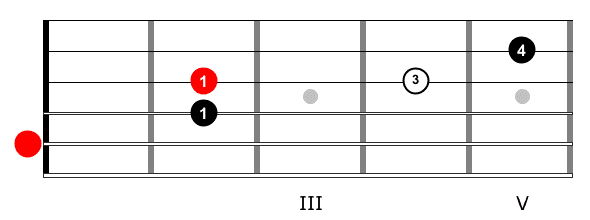
Chord synonyms, embellishments & suspension: 0:02-0:04 (synonyms), 0:05-0:06 (suspension), 0:14-0:15 (hammer-on/pull-off embellishment) – back to overview
Rhythm Figure & Picking Pattern
Let’s focus our attention on the rhythm for a moment and have a look at the rhythmic figure used for most parts of the track.
There’s a consistent pattern in use throughout most of the song. Interesting to note is the balance between notes landing on the strong beats and other notes being played on weaker parts of the beat. It’s this balanced approach that keeps the rhythm grounded and at the same time interesting.

Practice tip: when you dampen all strings with your left hand, you can focus on both the rhythm as well as the main picking pattern without getting distracted by changing chord shapes. Once the rhythm and picking pattern are ingrained, adding the left-hand chord changes will be a lot easier.
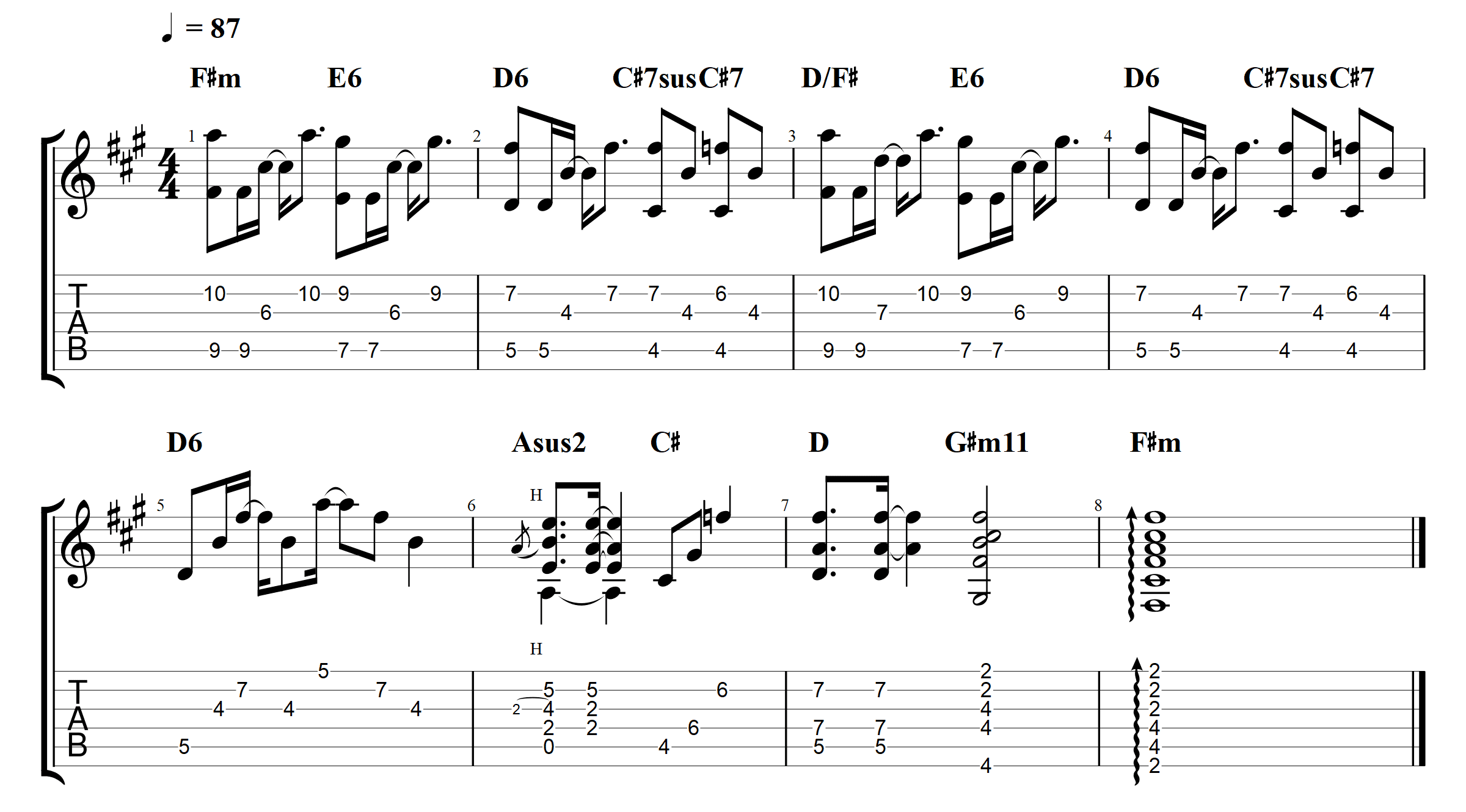
Modulation
There’s a modulation where on the studio recording the late great Larry Adler plays a moody harmonica solo. In this duet version there’s obviously no harmonica solo, but Sting does take a break for one cycle. Not only can you hear the modulation to C#m (down a 4th) but if you watch the video closely, you can also see how Dominic has shifted his chord shapes down a string set. Video time stamp: 2:24.
“‘Shape of my Heart’ was a case where the riff came first. Sting’s skill was taking it where it went, the key change and how we got back.”
Dominic Miller
Guitar Techniques Magazine, 1999/10, page 15
The modulation is extremely smooth and here’s how that smoothness is achieved: the G#m11 chord preceding the modulation is already familiar to the listener. It’s been regularly used in the progression as the second to last chord before the tonic F#m chord. So, we as listeners, have been conditioned to expect a resolution. G# also is the v of C#m, the key we are modulating to, for the solo section. V(m) to i – that works, right? And even though the minor 3rd is present in the chord, the 11th (which is the same as the 4th) gives the chord the hint of a suspension. Technically it’s not, but our ears can get tricked into (almost) perceiving the chord as a sus chord which makes the resolution to the new tonic C#m appear to be stronger.
Modulation: 2:19-2:46 – back to overview
Strumming for Increased Momentum
Pay attention to the brief switch to the strumming technique happening at 2:36. This is a model showcase for a transitional device that supports and heightens the return to both the original key as well as the regular fingerpicking pattern.
Strumming: 2:36-2:45 – back to overview
Horizontal Vibrato
Vibrato is one of the most important as well as personal techniques to add expression and emotion. Personal because it’s somewhat comparable to a sonic fingerprint. How often have you heard somebody say, “I knew it right after the 1st note – that’s guitarist X”? A guitarist’s tone as well as the playing techniques (which vibrato is a part of) play a large role in creating such a highly identifiable trademark sound.
On electric guitar vibrato is mostly created vertically. Most players repeat a series of bends and releases in quick succession and the fluctuation of pitch creates the vibrato effect. On acoustic guitar, especially with nylon strings, that’s not the usual way. Creating vibrato by bending up and down is more difficult and would also reduce string life considerably due to the friction. Therefore, the horizontal approach is the standard way of achieving the vibrato effect on acoustic guitar. This has the advantage that it’s actually possible to control the vibrato of multiple notes simultaneously to varying degrees. So you actually do have more control when using horizontal vibrato.
The video timestamp markers are not the only places where Dominic applies vibrato. I’ve simply marked those instances where you can clearly see his hand/finger movements in the video when adding vibrato.
I’d like to wrap up this short (you ain’t seen nothing yet) article with two quick observations. One from the beginning, and to close the circle, one from the end of the song.
Horizontal vibrato: 0:02, 0:08, 0:13, 0:46, 1:36-1:38, 1:41, 2:52-2:55 – back to overview
Adding the Melody at the End of the Intro
At the end of the intro Dominic incorporates the melodic line that is usually sung with the lyrics “that’s not the shape of my heart” into his part. Since the acoustic guitar is more exposed in this duet version, this detail has even more impact and also helps to establish this important melody line in the listener’s ear.

Added melody: 0:17-0:21 – back to overview
Color Chords for a Dramatic End
At the end Dominic creates extra tension by altering the V chord and playing C#7#5 before resolving to a colorful F#m add2 voicing. He then intersperses a Dadd2/F# chord for even more variety and a splash of additional color before the final resolution to the tonic F#m chord. Again, it’s details like this that add value and interest to a song.


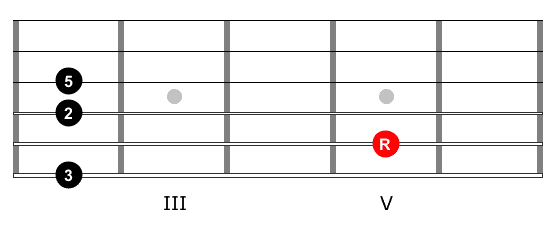
Color chords: 4:14-4:27 – back to overview
Conclusion
I hope you’ve enjoyed this song as much as I do. A simple song on the surface, there are lots of details to study, to steal and to incorporate into your own playing and songwriting. Focus especially on the open-voiced chord shapes, which are highly effective, especially on acoustic guitar.
Whether you’d like to learn and add “Shape of My Heart” to your repertoire or not, is up to you. But definitely do learn the open-voiced triad shapes in all chord qualities and inversions in all keys and on all string set combinations. At the very least, get the super-useful 10th intervals under your fingers. Most importantly – don’t just practice and hoard the shapes – use those new additions to your chord voicing arsenal!
Sources
Guitar Techniques Magazine 1999/10
Guitar Techniques Magazine 2009/06
Get notified whenever I publish a new article!
Absolutely NO Spam – Unsubscribe Anytime.
